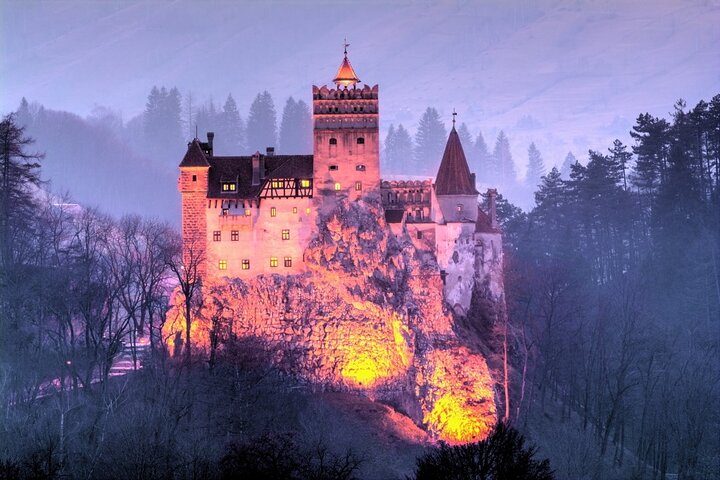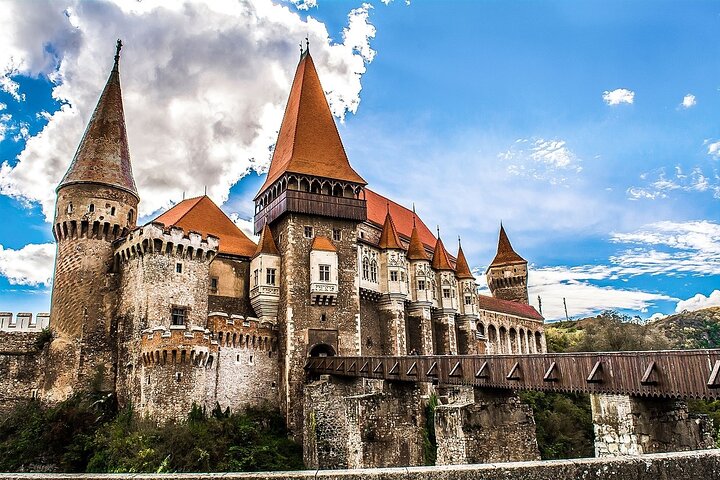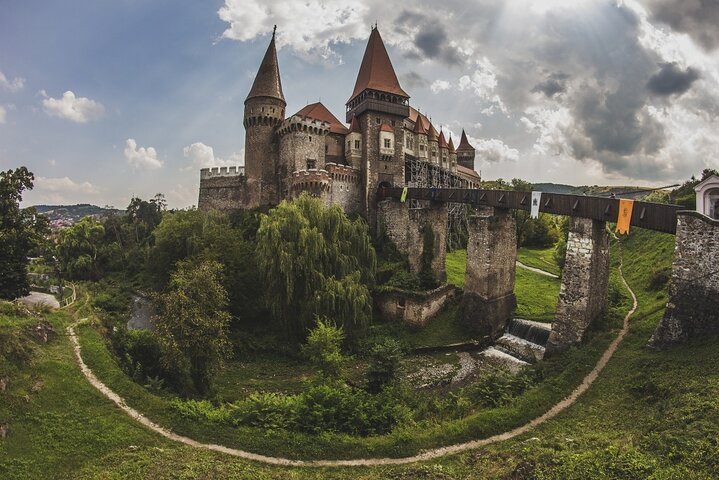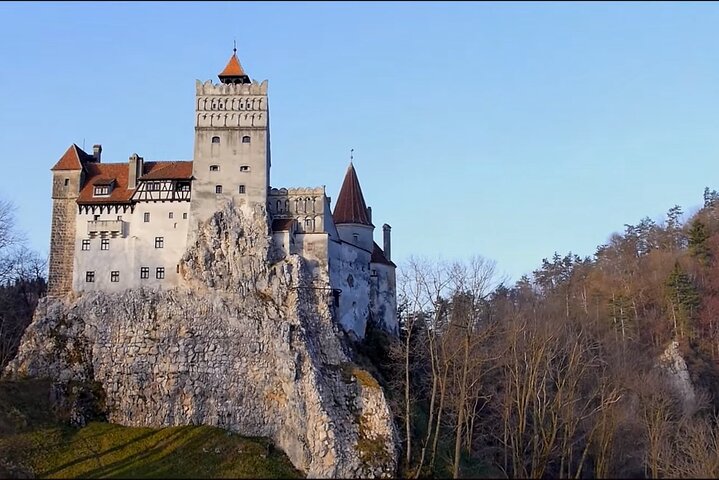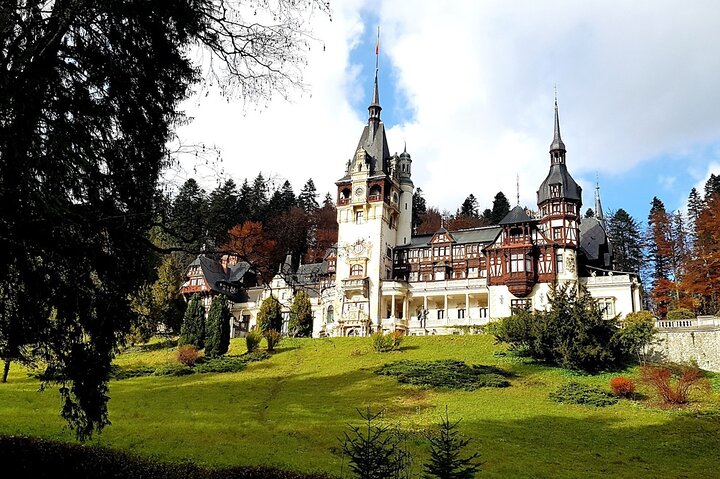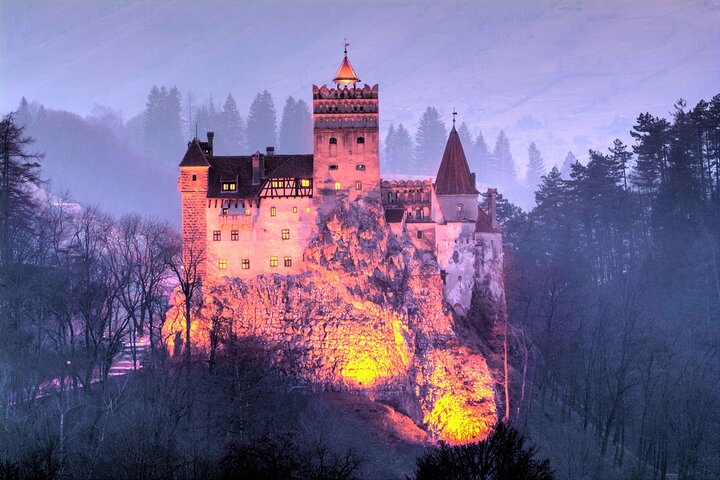Embark on an 8-day private tour of Romania from Bucharest and immerse yourself in the country’s rich history, stunning landscapes, and mouthwatering traditional cuisine. Explore medieval sites, enjoy funny stories during the drives, and get a true understanding of Romania and its people.
Embark on an 8-day private tour of Romania from Bucharest and immerse yourself in the country’s rich history, stunning landscapes, and mouthwatering traditional cuisine. Explore medieval sites, enjoy funny stories during the drives, and get a true understanding of Romania and its people.
1. Curtea de Arges Monastery 2. Poenari Castle 3. Transfagarasan Highway 4. Sibiu City Tour - Overnight stay in Sibiu
Curtea de Arges Monastery - Did you know that Curtea de Arges is renowned for the significant royal tombs it conceals? It is well-known that truly remarkable, beautiful, and enduring things often require sacrifice, a fact that…
1. Curtea de Arges Monastery 2. Poenari Castle 3. Transfagarasan Highway 4. Sibiu City Tour - Overnight stay in Sibiu
Curtea de Arges Monastery - Did you know that Curtea de Arges is renowned for the significant royal tombs it conceals? It is well-known that truly remarkable, beautiful, and enduring things often require sacrifice, a fact that becomes evident upon visiting the historic town of Curtea de Arges. With its rich and eventful past, visitors can explore the remnants of the Wallachian princely court, the 13th-century Royal Church, and the renowned Arges Monastery, a significant historical monument with a fascinating yet somber tale.
Poienari Castle - The ruins of Poienari Fortress are perched high on a cliff overlooking the Arges River, at the base of the Carpathian Mountains. Constructed in the early 13th century by the initial Wallachian rulers, the castle underwent several name and resident changes over the years before being abandoned and left in ruins. Recognizing the site’s potential, upon ascending the throne, he ordered the structure’s repair and fortification, transforming it into one of his primary fortresses. When the Turks attacked and seized the castle in 1462, Vlad made his escape through a secret passageway leading north through the mountains.
Big Square (Piata Mare) - If you find yourself in Transylvania, Sibiu is a must-visit destination with a 900-year history. A city tour will help you understand why Sibiu was chosen as the European Capital of Culture, featuring the Evangelical Cathedral, the Sibiu Old City Center, and the town itself, which are among Romania’s most visited tourist attractions, catering to all tastes and offering a delightful travel experience for even the most discerning tourists.
For those who appreciate authentic cultural experiences, whether romantic or adventurous, Sibiu offers everything needed to relax and enjoy, leaving behind everyday stress for a fun and memorable trip. The beauty of this ancient citadel, recognized for its architecture, street layout, cultural and artistic heritage, and stunning natural scenery, is flanked by the Fagaras and Lotru mountains.
Transfagarasan Highway - Stretching over 150 kilometers, the Transfagarasan Highway is Romania’s most spectacular and renowned road, gaining fame from its feature on BBC’s Top Gear in 2009, making it one of the country’s top tourist attractions. Open fully only from June to October, the road’s highest point is at 2042 meters, where a tunnel connects the northern and southern sides at Lake Balea (Balea Lac).
1. Turda Salt Mine 2. Cluj Napoca 3. Surdesti Wooden Church - Overnight in Vadul Izei (Maramures)
Salina Turda - This location is a visual and physical delight, as the purifying saline air is especially beneficial for those with respiratory issues like allergies or asthma. Visitors can explore remnants of Roman heritage, as salt mining in the area dates back thousands of years. The site includes the former Iosif, Terezia, and Rudolf mines, and unique medieval salt exploitation machinery in Europe, such as the crivac (or gepel), the salt mill, an altar carved into the salt wall, and the “Stairway of the Rich” with its intricate woodwork.
Gradina Botanica “Alexandru Borza” - A Cluj Napoca City Tour should be on your itinerary if you pass through Transylvania during your Romanian trip. Prepare your camera for the Old City Center, which boasts unique historical and architectural monuments, Baroque, Renaissance, and Gothic-style buildings, some dating back to the 17th century, along with friendly and welcoming locals. The popular local cuisine and restaurants may require a wait before you can enjoy a meal.
Surdesti Wooden Church - The warmth of wooden constructions is unmatched, and the Surdesti church offers even more. Visitors are often so impressed they metaphorically tip their hats, not surprising given the church’s tower measures an impressive 54 meters. Imagine the craftsmanship involved in creating this 72-meter high wooden masterpiece, a challenging task even with modern technology, and considering it was built in 1721, it’s no wonder it’s considered an architectural marvel.
1. Explore Maramures (local market) 2. Merry Cemetery 3. Sighet Memorial Museum - Overnight in Vadul Izei (Maramures)
Merry Cemetery - This Romanian journey promises history, culture, adventure, and fun. The Dacians, our brave and wise ancestors who worshiped the god Zalmoxis, would laugh at funerals and cry at births. In Maramures, traces of historical continuity remain, most notably in Sapanta, home to the unique Merry Cemetery. The crosses and tombstones, each a skillful and colorful work of art, feature humorous poems about the deceased that will leave you in stitches.
Memorial of the Victims of Communism and of the Resistance - To understand why Romanians fought so hard to escape communist oppression, visit the Memorial Museum for the Victims of Communism. It offers insight into the totalitarian regime’s damaging impact and the immense pain and suffering it caused in a short time.
Sapanta-Peri Monastery - Sapanta Peri Monastery is a significant church in Maramures. Located near Sapanta Village within a dendrology park, the wooden church was built in 1391. In 1391, Dragos Voda’s nephews donated lands and properties to Peri Monastery, leading to the construction of a stone church. For 312 years, the Romanian Diocese of Maramures used the stone church as its headquarters, with the Archangel Michael (Sfantul Arhanghel Mihail) as the patron saint.
1. Barsana Monastery 2. Borgo Pass Road 3. Ciocanesti Village - Overnight in Gura Humorului
Barsana Monastery - One of Romania’s tallest wooden churches (57m height). Walking barefoot through the grass connects you to the earth, and stepping into the courtyard of Romania’s most beautiful wooden monastery, Barsana Monastery, connects you spiritually to the sky and God. If you think you’ve seen breathtaking places before, this trip to Maramures might change your mind. With its enchanting scenery and timeless history, this magical place has captivated tourists and locals for centuries.
Tihuța Pass - Tihuta Pass, or Borgo Pass, is located in the country’s north, allowing passage across the Bârgău mountains from Moldavia to Transylvania. Situated at 1201m, between Măgura Calului peak (1229m) and Piatra Fântânele mountain (1067m), the road was first built between 1812-1817 by the Austro-Hungarian Army’s Council of War. Paved in 1969, the road is often busy, with trucks causing delays, but few villages along the route allow for acceptable cruising speeds. The road is in excellent condition, with smooth asphalt and many wide curves that will bring a smile to your face. Don’t forget to stop and admire the stunning views.
Ciocanesti - A village in Northern Romania, Ciocanesti is one of Europe’s most colorful destinations, according to Lonely Planet. In “Places that pop: 10 of Europe’s most colourful destinations,” Lonely Planet writer Tamara Sheward lists “vibrant villages, technicolour towns, and dazzling districts” worth visiting, including Ciocanesti commune in Suceava county, Northern Romania. “Carpathian Mountains. The name conjures images of vampires, werewolves, and enchanted forests. But in Bucovina, Ciocanesti defies every spooky cliché: what could be less terrifying than a village painted like Easter eggs?” reads the description.
1. Voronet Monastery 2. Sucevita M. 3. Moldovita M. 4. Humor M. 5. Egg Painted Museum - Overnight in Gura Humorului
Manastirea Voronet - The Voroneț Monastery is a medieval monastery in the Romanian village of Voroneț, now part of Gura Humorului. It is one of the famous painted monasteries from southern Bukovina, in Suceava County. Constructed by Stephen the Great in 1488 over 3 months and 3 weeks to commemorate the victory at the Battle of Vaslui, it is often called the “Sistine Chapel of the East.” The frescoes at Voroneț feature an intense shade of blue known in Romania as “Voroneț blue.”
Did you know that Voronet Monastery was founded by Stephen the Great? Dubbed the “Sistine Chapel of the East,” it attracts tens of thousands of tourists annually, with at least three unique elements making it a highlight of your Moldavia and Bucovina trip. The most impressive aspect of the church’s artwork, both inside and outside, is the exceptional background color – the famous Voronet blue!
Humor Monastery - To understand the importance of religion to our people, tour Romania and see the numerous houses of worship built and destroyed by enemies over history. To protect their spiritual treasures, people built churches away from the world, some hidden in woods, others nestled in rock caves at high altitudes. Humor Monastery, built around 500 years ago, is a fortified monastery that has endured through the centuries. After the first church here, built around 1400, was destroyed, the second one, built in 1530 with thick river rock walls, was meant to be a place of worship that would withstand time.
Sucevita Monastery - Sucevita and Voronet are two of Romania’s most beautiful monasteries, part of the international cultural and spiritual heritage, making them essential stops on any trip to Romania and northern Moldavia. Even if you haven’t read the Bible, the biblical scenes and icons painted on Sucevita Monastery’s walls provide stunning visual support for understanding Christianity’s history. The fortified church is like an open book for anyone who enters, and seeing it in person reveals why it was included on the UNESCO World Heritage list of cultural landmarks.
Moldovita Monastery - For a spiritual journey to a place echoing with the fervent prayers of countless people who found solace here over history, visit one of Romania’s oldest monastic settlements, built in 1532, home to Moldovita Monastery. The fortified church combines Byzantine, Gothic, and Moldavian styles, but its unique mural artwork, both inside and outside, truly impresses visitors.
Muzeul International al Oualor Lucia Condrea - Since the summer of 1993, artist Lucia Condrea has opened a museum in Moldovita (Bukovina, Suceava- Romania) bearing her name, unique in Romania and possibly the world, given the artistic value of the exhibits. The museum contains over 5500 exhibits, artistically arranged across two levels in 56 display cases.
1. Bicaz Gorge 2. Nicolae Popa Museum 3. Red Lake - Overnight in Sighisoara
Bicaz Canyon - The gorge was carved by the Bicaz River and serves as a passageway between Moldova and Transylvania. It is a noted location to see the wallcreeper, a rare cliff-dwelling bird. The road along the 8 kilometers of ravines, often in serpentines with rock on one side and a sheer drop on the other, is one of the country’s most spectacular drives. Also within the gorge is Lacul Roșu (the Red Lake), with its traditional cabins, hotels, and its famous lake (situated at 980m altitude) caused by a landslide in the 19th century. Cheile Bicazului is one of Romania’s main rock climbing sites.
Lacu Rosu - Although the Red Lake is a young formation, the conditions and time of its formation are much discussed. During its formation, the lake area was hardly accessible and economically unexplored. According to Franz Herbich, the Red Lake was formed in 1838, justified by the earthquake of January 23, 1838, which was repeated in February and could have caused a landslide. Another formation year is 1837, argued by violent storms and heavy rains.
The Popa Museum - 12 kilometers from Targu Neamt, in Tarpesti, Neamt County, you can visit the notable Nicolae Popa Museum. Founded in the ‘70s by local sculptor Nicolae Popa in his own home, the museum showcases his work. After being wounded in World War II, imprisoned by communists for opposing the regime, and left with only his house, Nicolae Popa stood for Romanian values. Through hard work and dedication, driven by a strong artistic inclination, he became one of Romania’s most valued naive sculptors and a true folklore creator.
1. Sighisoara City Tour 2. Viscri Village 3. Brasov City Tour - Overnight in Brasov
Sighisoara Clock Tower - Begin the Sighisoara Old Town tour with a visit to the Clock Tower and Arms museum. To experience life in the Middle Ages, visit Sighisoara, Romania’s medieval town, and Count Dracula’s (Vlad the Impaler) birthplace. Built in 1280, the Sighisoara Citadel is not only a top tourist attraction in Romania but also a living medieval fortress, inhabited for over 700 years, which is quite rare.
Village de Viscri - With a history dating back to the 12th century, Viscri is perhaps Romania’s most famous village. Prince Charles’ visits, its fortified church, and the Mihai Eminescu Trust’s activities have helped this small village reinvent itself in recent years. Its promotion was so successful that Viscri is now one of Transylvania’s must-see attractions.
Piaka Sfatului - The Council Square (Piața Sfatului in Romanian, former Marktplatz in German, Főtér or Tanács tér in Hungarian) is located in Brașov’s historic center, Romania. It obtained market rights in 1520, but has hosted weekly and annual markets since 1364, attracting merchants from near and far. Surrounded by 18th-19th century houses, most of which are historical monuments.
1. Bran Castle 2. Peles Castle 3. Sinaia Monastery - Back to Bucharest
Bran Castle (Dracula’s Castle) - Bran Castle, a blend of myth and history. Bram Stoker’s fictional portrayal of Dracula’s castle closely matches Bran, leading many to believe he used its descriptions to create Count Dracula’s fictitious home. Outside the castle, enjoy traditional foods: handmade cheeses, pálinka (plum and pear brandy), and traditionally-produced ham and sausages.
Peles Castle - Once upon a time, there was a beautiful castle… If you plan to write your memoirs or boast about seeing Europe’s most beautiful castles, the Romanian royal family’s summer residence is a top tourist attraction in Romania and Europe, and you’ll soon understand why. Every year, thousands of notable figures and hundreds of thousands of tourists visit Romania for this attraction alone, to admire its beauty and feel like royalty, even if just for a few hours.
Manastirea Sinaia - The Sinaia Monastery, located in Sinaia, Prahova County, Romania, was founded by Prince Mihail Cantacuzino in 1695 and named after Saint Catherine’s Monastery on Mount Sinai in Egypt. As of 2005, it is home to 13 Christian Orthodox monks led by hegumen Macarie Boguș, and is part of the Bucharest archdiocese.

- Exclusive private car (Tourism or Minibus) for your group
- Tailored hotel recommendations to fit your budget
- Dedicated licensed English-speaking guide/driver for the entire tour
- Complimentary Wi-Fi in a comfortable car
- Guide’s accommodation, meals, and entrance fees included
-
All car expenses covered, including gasoline, parking, and tolls
-…
- Exclusive private car (Tourism or Minibus) for your group
- Tailored hotel recommendations to fit your budget
- Dedicated licensed English-speaking guide/driver for the entire tour
- Complimentary Wi-Fi in a comfortable car
- Guide’s accommodation, meals, and entrance fees included
- All car expenses covered, including gasoline, parking, and tolls
- Flexible itinerary with the freedom to modify post-tour start
- Accommodation, meals and beverages
- Entrance fees as per the itinerary
- Accommodation, meals and beverages
- Entrance fees as per the itinerary
We’re going on a journey filled with humor and insightful anecdotes :) It’s the optimal way to comprehend Romania and its people!
For an unforgettable escapade, we’ve curated an array of diverse experiences for this 8-day Romanian tour. From exploring medieval landmarks to relishing the untouched wilderness, breathing in crisp mountain air (depending on…
We’re going on a journey filled with humor and insightful anecdotes :) It’s the optimal way to comprehend Romania and its people!
For an unforgettable escapade, we’ve curated an array of diverse experiences for this 8-day Romanian tour. From exploring medieval landmarks to relishing the untouched wilderness, breathing in crisp mountain air (depending on the season), and experiencing modern exhibits. Plus, we’ll also be adding a hint of local herbs and spices to the culinary delights we’ll sample in each historical town we stop at.
For a full refund, cancel at least 24 hours before the scheduled departure time.
For a full refund, cancel at least 24 hours before the scheduled departure time.
